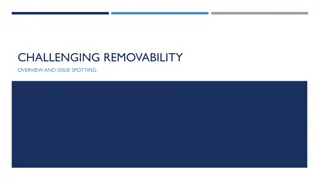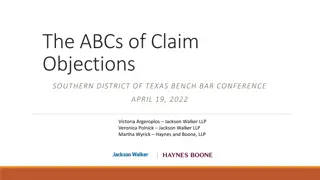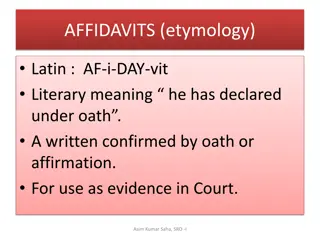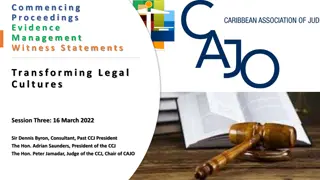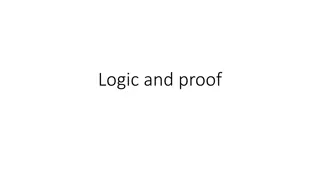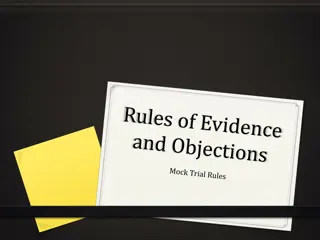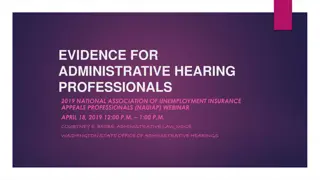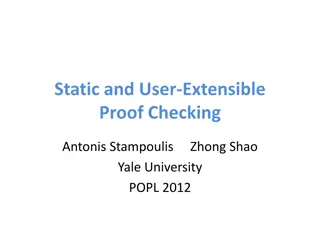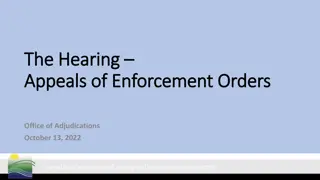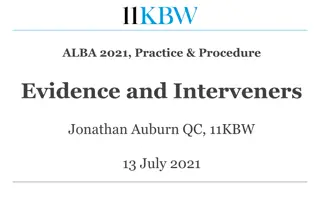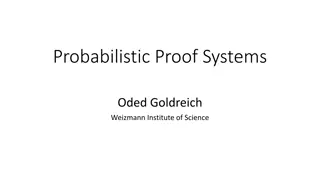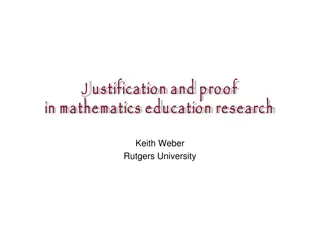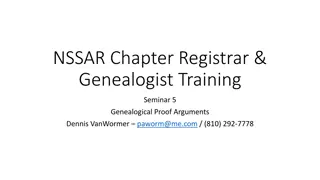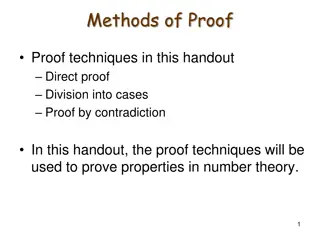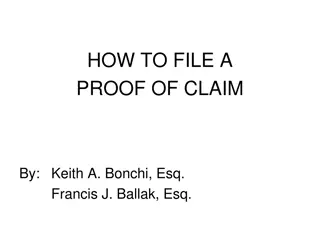Understanding Burden of Proof and Standards of Evidence in Legal Proceedings
In legal proceedings, the burden of proof determines which party must prove their case to the trier of fact. The standard of proof refers to the level of certainty required to establish proof, with higher stakes demanding a higher standard. Decision-makers must apply clear and convincing evidence standards in determining responsibility, ensuring fairness and accuracy in judgments.
Uploaded on Oct 05, 2024 | 0 Views
Download Presentation

Please find below an Image/Link to download the presentation.
The content on the website is provided AS IS for your information and personal use only. It may not be sold, licensed, or shared on other websites without obtaining consent from the author. Download presentation by click this link. If you encounter any issues during the download, it is possible that the publisher has removed the file from their server.
E N D
Presentation Transcript
CLEAR AND CONVINCING EVIDENCE
Basic requirements for grievance process. A recipients grievance process must State whether the standard of evidence to be used to determine responsibility is the preponderance of the evidence standard or the clear and convincing evidence standard, apply the same standard of evidence for formal complaint against students as for formal complaints against employees, including faculty, and apply the same standard of evidence to all formal complaints of sexual harassment. Sec. 106.45(b)(1)(vii) NEW TITLE IX REGULATIONS
In each case, one side has the burden of proof. Having this burden means the party must prove its case to the trier of fact judge or jury, whoever is weighing the evidence. The burden of proof can shift from one side to the other during a hearing or a trial depending on the kind of case. WHAT IS A BURDEN OF PROOF?
The level of certainty and the degree of evidence necessary to establish proof in a criminal or civil proceeding WHAT IS A STANDARD OF PROOF
The standard of proof refers to the extent to which the party with the burden of proof has to prove its case (or an element of its case). In general, the higher the stakes, the higher the standard of proof. A higher standard of proof means that, to find for the side with the burden of proof, the trier of fact has to be more certain that that side has proved its case. WHAT IS A STANDARD OF PROOF
Complicated concept Becomes less complicated only after using it many, many times. Requires certain things on the part of the person or group of people (read jury) exercising it: Judgment Discretion Discernment STANDARD OF PROOF
Determination regarding responsibility Decision-makers must apply the [clear and convincing] standard of evidence . Sec. 106.45(b)(7)
G. Standard of Proof The decision makers will make a decision of the alleged violation(s) based on the Clear and Convincing standard. This standard requires that the information supporting a finding of responsible demonstrate that a particular fact is substantially more likely than not to be true. Under this standards, individuals are presumed to have not engaged in a policy violation of sexual misconduct unless it is substantially more likely than not based on the information provided that a violation of the Prohibited Conduct did occur. PLU S SEXUAL MISCONDUCT POLICY
VI. DECISIONS Review Officers and Decision Makers for student code of conduct cases weigh information against the standard of clear and convincing and may come to one of the following decisions for each alleged violation: . PLU S STUDENT CODE OF CONDUCT PROCEDURES
Defining the clear and convincing standard in the context of a Title IX case, as when it is highly probable or reasonably certain that the sexual harassment or violence occurred. SurvJustice Inc. v. DeVos, No. 18-CV-00535-JSC, 2018 WL 4770741, at *2 (N.D. Cal. Oct. 1, 2018), order amended on reconsideration, No. 18-CV-00535-JSC, 2019 WL 1434144 (N.D. Cal. Mar. 29, 2019) CASE DEFINITION OF CLEAR AND CONVINCING
Clear and convincing evidence must produce a firm belief about the facts to be proved. It must be more than evidence that simply outweighs or overbalances the evidence opposed to it. Nimer v. Case W. Reserve Univ., No. 1:18CV2269, 2018 WL 5118306, at *3 (N.D. Ohio Oct. 22, 2018) CASE DEFINITION OF CLEAR AND CONVINCING
STANDARDS OF EVIDENCE MATH. PROB. EST. STANDARD DEFINITIONS TYPES OF CASES WHERE USED NOTES requires more than a mere scintilla of evidence The concept of substantial evidence is also used within determinations of whether other standards of proof have been met. Used primarily in administrative law proceedings. Requires moving party to provide enough evidence that a reasonable mind could accept as adequate to support a particular conclusion. Substantial Evidence Requires jury to return judgment in favor of plaintiff if plaintiff can show that a particular fact or event was more likely than not to have occurred. Usual standard in civil litigation, e.g., car accidents--is it more likely than not that the traffic light was green Preponderance of Evidence 50.1% more likely than not Use of Substantial Evidence in the context of Preponderance of Evidence standard: There is substantial evidence to support our finding the preponderance of evidence.
STANDARDS OF EVIDENCE, CONTD MATH. PROB. EST. STANDARD DEFINITIONS TYPES OF CASES WHERE USED NOTES Highest evidentiary standard employed in civil proceedings, second only beyond a reasonable doubt in criminal proceedings. Use of Substantial Evidence in the context of Clear and Convincing Evidence: There is substantial evidence to support our finding that the clear and convincing standard has been met. Used in civil lawsuits where something more than money is at stake, such as civil liberties, e.g., restraining orders, dependency cases (loss of parental rights), probate of wills and conservatorships. Also used in civil commitment cases, libel cases, deportation cases, denaturalization cases. A party must present sufficient evidence to produce in the ultimate factfinder an abiding conviction that the truth of its factual contentions are highly probable. 70% Factfinder need not be absolutely certain, but highly confident, about the fact in issue. Clear and Convincing to Other terms are sometimes used to describe this standard, such as clear, cogent and convincing. 75% Proof that a particular fact is substantially more likely than not to be true to produce a firm belief of conviction in the factfinder as to the allegations sought to be established. Existence of fact must be highly probable. Some courts have described this standard as requiring proof that there is a high probability that a particular fact is true. Must be more than evidence that simply outweighs or overbalances the evidence opposed to it. This standard requires the prosecution to show that the only logical explanation that can be derived from the facts is that the defendant committed the alleged crime, and that no other logical explanation can be inferred or deduced from the evidence. Use of Substantial Evidence in the context of a case requiring proof Beyond a Reasonable Doubt: There is substantial evidence to support our finding that the Beyond a Reasonable Doubt standard has been met. Used primarily in criminal cases, where loss of liberty or life is at stake. Beyond a Reasonable Doubt 95% What is required is not an absolute or mathematical certainty, but a moral certainty.


